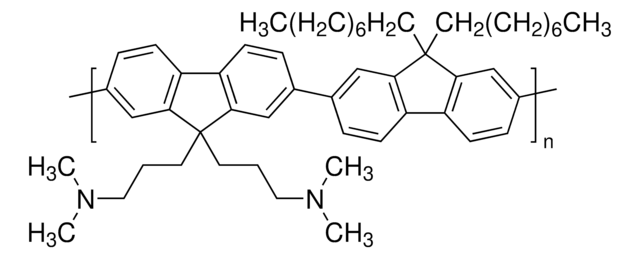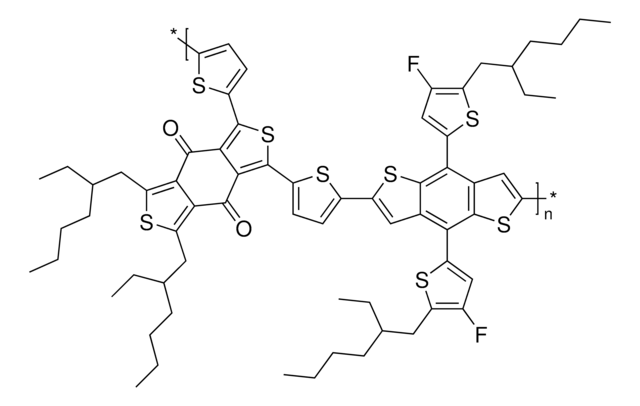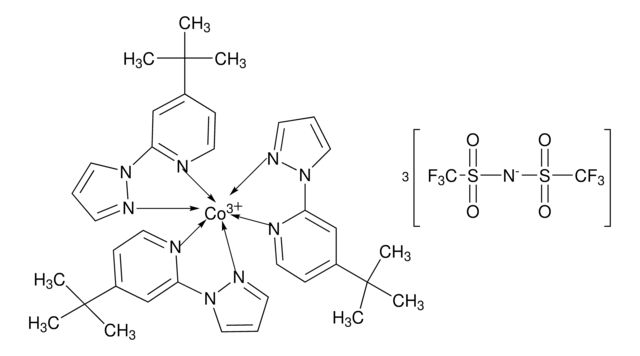推薦產品
形狀
solid
分子量
Mw 30,000-50,000 by GPC
環保替代產品特色
Design for Energy Efficiency
Learn more about the Principles of Green Chemistry.
sustainability
Greener Alternative Product
顏色
beige to yellow
mp
>200 °C
溶解度
DMF: soluble
DMSO: soluble
alcohol: soluble
chloroform: insoluble
water: soluble
蛋白質二硫鍵異構酶
2‑3.2
環保替代類別
, Enabling
尋找類似的產品? 前往 產品比較指南
一般說明
我们竭诚为您带来绿色替代产品,确保符合一项或多项绿色化学12项原则要求。该产品属于绿色替代产品,因此符合“节能设计”的要求。电子传输有机材料具有传输电子的化学功能,并用作OLED器件中的电子传输层。 点击此处以获取更多信息。
應用
PFN-Br是可溶液加工的共轭聚电解质材料,可用作高性能有机光伏电池(OPV)和有机发光二极管(OLED)的界面层,提高其界面性能。
采用PFN-Br界面层的有机太阳能电池在短路电流密度、开路电压、填充因子参数的性能上都有增强,倒置OPV的效率提高。这是因为PFN-Br使ZnO电子提取层和活性层之间接触更易,电子提取层和活性层之间的界面结合性更好,并通过抑制双分子复合增强电荷传输。
最近报道的能量转换效率达17.3%的有机太阳能电池也采用了PFN-Br材料,将其旋涂在ZnO上以提高界面性能。
叠层电池性能:
ITO/ZnO/PFN-Br/PBDB-T:F-M/M-PEDOT/ZnO/PTB7- Th:O6T-4F:PC71BM/MoO3/Ag
Voc=1.642 V
Jsc=14.35 mA/cm2
FF=73.7%
PCE=17.3%
PFN-Br应用领域广泛:
采用PFN-Br界面层的有机太阳能电池在短路电流密度、开路电压、填充因子参数的性能上都有增强,倒置OPV的效率提高。这是因为PFN-Br使ZnO电子提取层和活性层之间接触更易,电子提取层和活性层之间的界面结合性更好,并通过抑制双分子复合增强电荷传输。
最近报道的能量转换效率达17.3%的有机太阳能电池也采用了PFN-Br材料,将其旋涂在ZnO上以提高界面性能。
叠层电池性能:
ITO/ZnO/PFN-Br/PBDB-T:F-M/M-PEDOT/ZnO/PTB7- Th:O6T-4F:PC71BM/MoO3/Ag
Voc=1.642 V
Jsc=14.35 mA/cm2
FF=73.7%
PCE=17.3%
PFN-Br应用领域广泛:
- 有机太阳能电池界面层(金属氧化物致密层)
- 有机发光二极管(OLED)电子传输层
- 钙钛矿太阳能电池(PSC)
- 柔性印刷电子器件
- 阳离子聚合物电解液
- 阴离子交换材料
- 发光电化学电池
其他說明
作为有机太阳能电池的电子传输层,建议使用浓度为0.2 mg/ml。
儲存類別代碼
11 - Combustible Solids
水污染物質分類(WGK)
WGK 3
閃點(°F)
Not applicable
閃點(°C)
Not applicable
客戶也查看了
Simultaneous enhancement of the molecular planarity and the solubility of non-fullerene acceptors: Effect of aliphatic side-chain substitution on the photovoltaic performance.
Z Zhang, et al.
Journal of Material Chemistry A, 5, 7776-7783 (2017)
Inverted polymer solar cells with 8.4% efficiency by conjugated polyelectrolyte
Yang T, et al.
Energy & Environmental Science, 5, 8208-8214 (2012)
Lingxian Meng et al.
Science (New York, N.Y.), 361(6407), 1094-1098 (2018-08-11)
Although organic photovoltaic (OPV) cells have many advantages, their performance still lags far behind that of other photovoltaic platforms. A fundamental reason for their low performance is the low charge mobility of organic materials, leading to a limit on the
文章
Professor Chen (Nankai University, China) and his team explain the strategies behind their recent record-breaking organic solar cells, reaching a power conversion efficiency of 17.3%.
我們的科學家團隊在所有研究領域都有豐富的經驗,包括生命科學、材料科學、化學合成、色譜、分析等.
聯絡技術服務
![聚[双(4-苯基)(2,4,6-三甲基苯基)胺] a poly(triaryl amine) semiconductor](/deepweb/assets/sigmaaldrich/product/structures/122/933/c34a34ab-284f-4890-adb8-126247a91d9b/640/c34a34ab-284f-4890-adb8-126247a91d9b.png)

![聚[(9,9-二正辛基芴基-2,7-二基)-alt-(苯并[2,1,3]噻二唑-4,8-二基)] average Mn ≤25000](/deepweb/assets/sigmaaldrich/product/structures/428/661/1c4ebb98-9d51-48c0-96c7-e556ca425aa4/640/1c4ebb98-9d51-48c0-96c7-e556ca425aa4.png)

![[6,6]-苯基 C 61 丁酸甲酯 ≥99%](/deepweb/assets/sigmaaldrich/product/structures/359/221/d990c746-0960-4c69-bf76-fe09b193824d/640/d990c746-0960-4c69-bf76-fe09b193824d.png)







